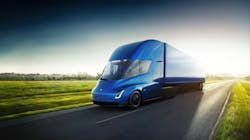Follow the money to understand autonomous truck developments
Autonomous trucks are coming.
And while no pundit or expert can be sure about when fully autonomous trucks will appear on the market, or predict how high the initial automation levels will be, you only have to follow the money to understand that a lot of cash-flush start-ups, as well as traditional truck OEMs with immensely deep pockets, are investing heavily in this new technology. And the stakes are high. The first companies to come to market with viable autonomous control systems for commercial vehicles will be at the vanguard of a completely new way of moving freight. And poised to make massive profits from it.
The numbers on the investments being made in autonomous truck technology is simply stunning. The Chinese-American start-up TuSimple, for example, made headlines last year when it achieved the much-vaunted “Unicorn” status on Wall Street — a term traders give to the extremely rare start-ups that are able to garner a $1 billion or more in outside investments. On a similar note, Daimler Trucks announced at the 2019 Consumer Electronics Show that it was investing more than $500 million in its Autonomous Technology Group.
Meanwhile, Daimler’s arch-rival on the global commercial vehicle stage, Volvo Group, has scored some early successes with autonomous mining trucks and its ground-breaking Vera logistics tug — a battery electric-powered autonomous yard tractor that is already undergoing validation trials in Europe. Volvo also has teamed up with automotive technology developer Nvidia to develop autonomous control systems for regional- and long-haul commercial vehicles.
Navistar also has gotten in the autonomous game, announcing a partnership with the aforementioned TuSimple earlier this month to develop a series of long-haul Class 8 commercial vehicles, designed from the group up that will use TuSimple’s autonomous control technology.
And that’s just the money coming in from the development side of the technology equation. Potential end-users also are investing significant sums of money in order to boost research and have some input as to how these systems will function in real-world fleet applications.
Early adoptions will likely be in private depots, where autonomous yard spotters will have the ability to free the driver from the very tough jobs of backing into docks or parking trailers. I know, we live in a 41 foot 5th wheel camper and the toughest part of my logistics is backing into a campground spot. And cases where the following tractor trailer of a two-truck platoon might be driverless, or even limiting the self-driving miles to only exit to exit interstates. These remove many of the challenges of driving an autonomous truck for all its necessary tasks.
Cutting-edge technology and transportation companies like UPS, Fed Ex, and Amazon — to name just three high-profile examples — are also both investing heavily in autonomous technology and partnering with the companies developing it. And investments and partnerships like these are being formed all over the globe. Because the race to develop safe and efficient autonomous trucks is not merely confined to North America. Indeed, this is technology that is poised to revolutionize freight transportation around the entire globe.
That’s because autonomous commercial vehicles have shown tremendous promise for solving many of the problems fleets are facing. Tech developers say autonomous trucks have the potential to mitigate a diverse range of issues fleets are dealing with, including delivering consistently improved fuel economy compared to human drivers, easing traffic congestion, vastly increasing vehicle utilization, reducing maintenance costs, fully integrating with blockchain, digital freight apps and other transparent, real-time freight management systems all the way down to simply easing the decades-long driver shortage.
Because, at the end of the day, technology is merely using the latest developments to solve problems. And that, in a nutshell, is why such vast amounts of investment dollars are flowing toward autonomous truck innovators today.
About the Author

Michael Roeth
Executive Director
Michael Roeth is the executive director of the North American Council for Freight Efficiency. He serves on the second National Academy of Sciences Committee on Technologies and Approaches for Reducing the Fuel Consumption of Medium and Heavy-Duty Vehicles and has held various positions with Navistar and Behr/Cummins.
